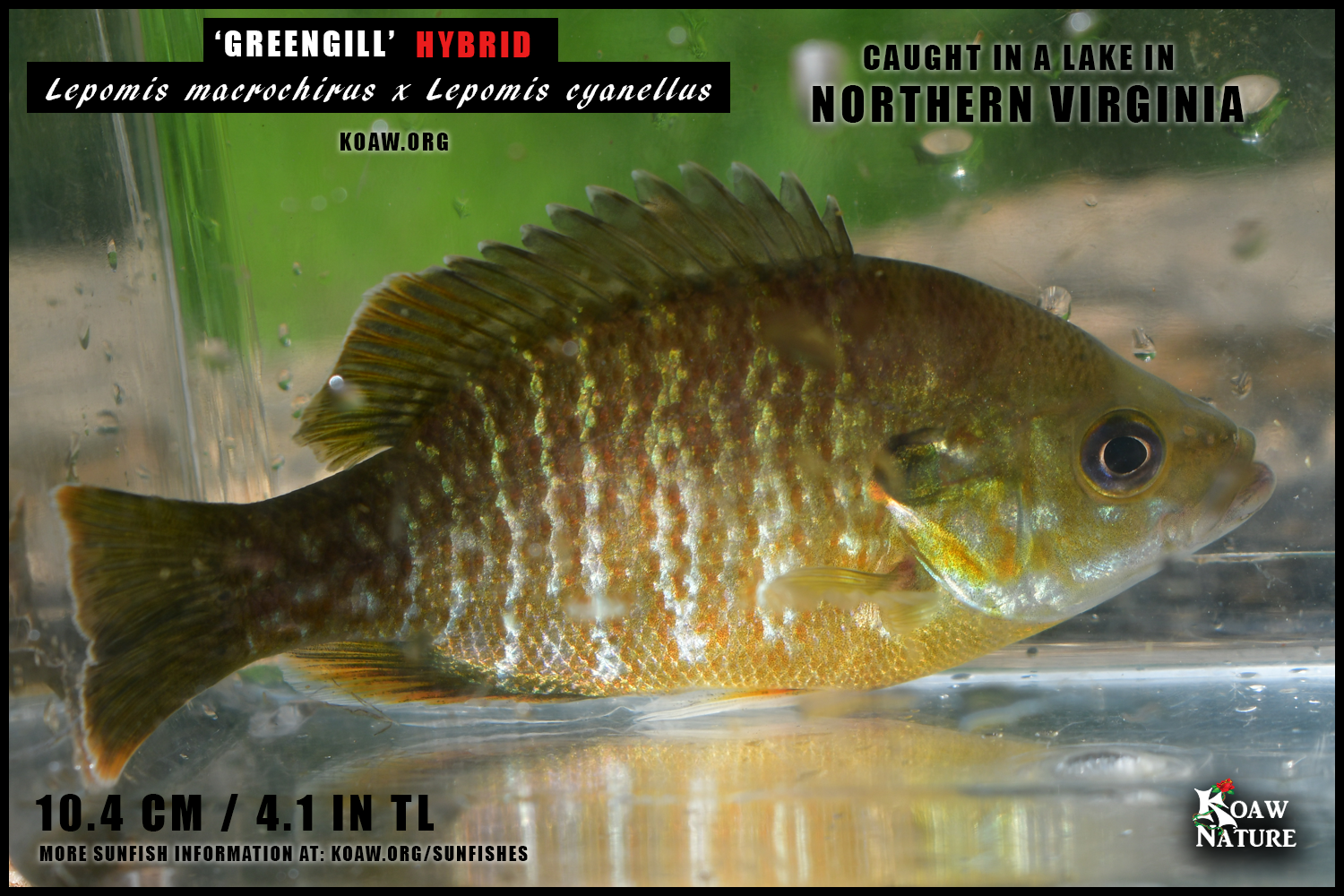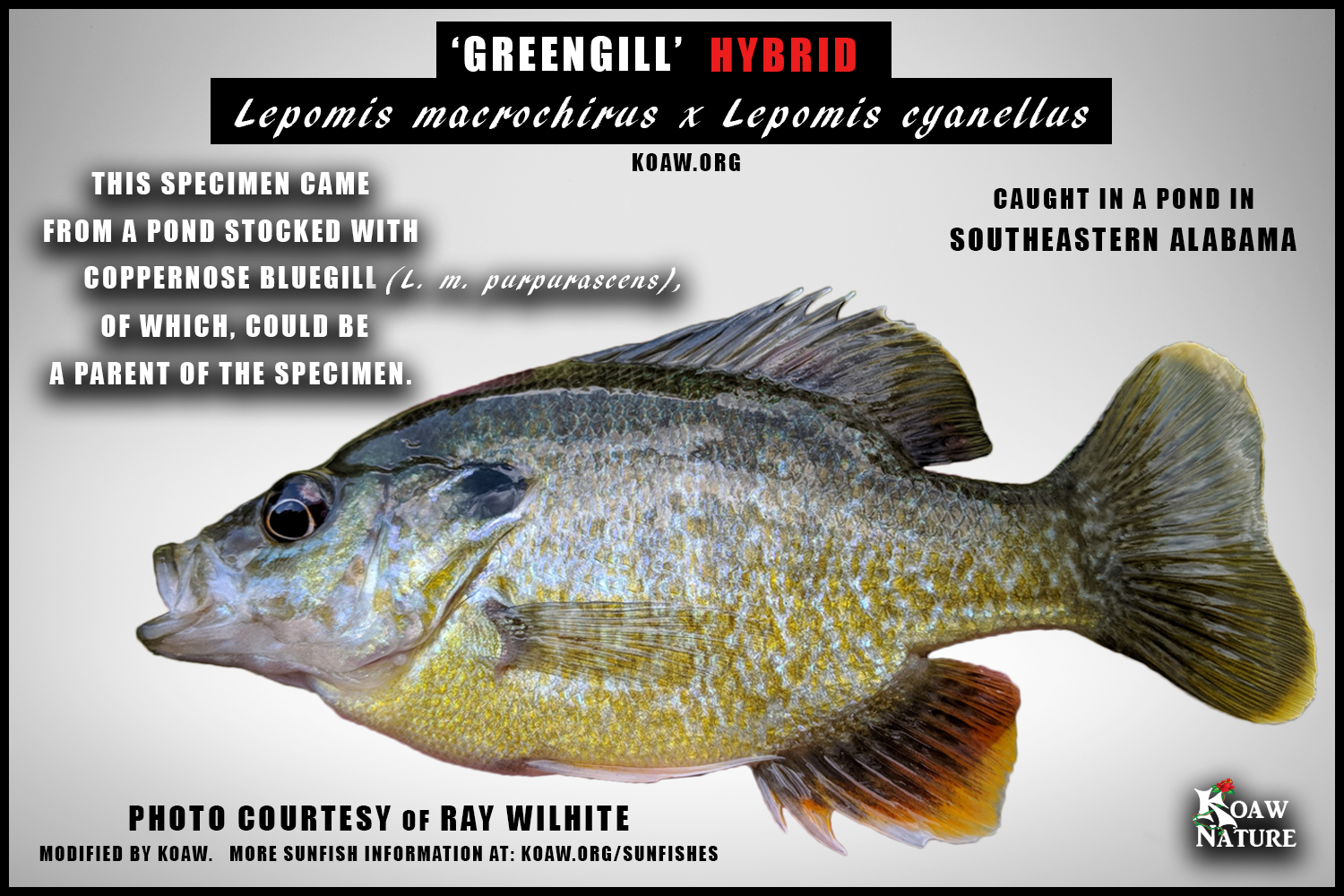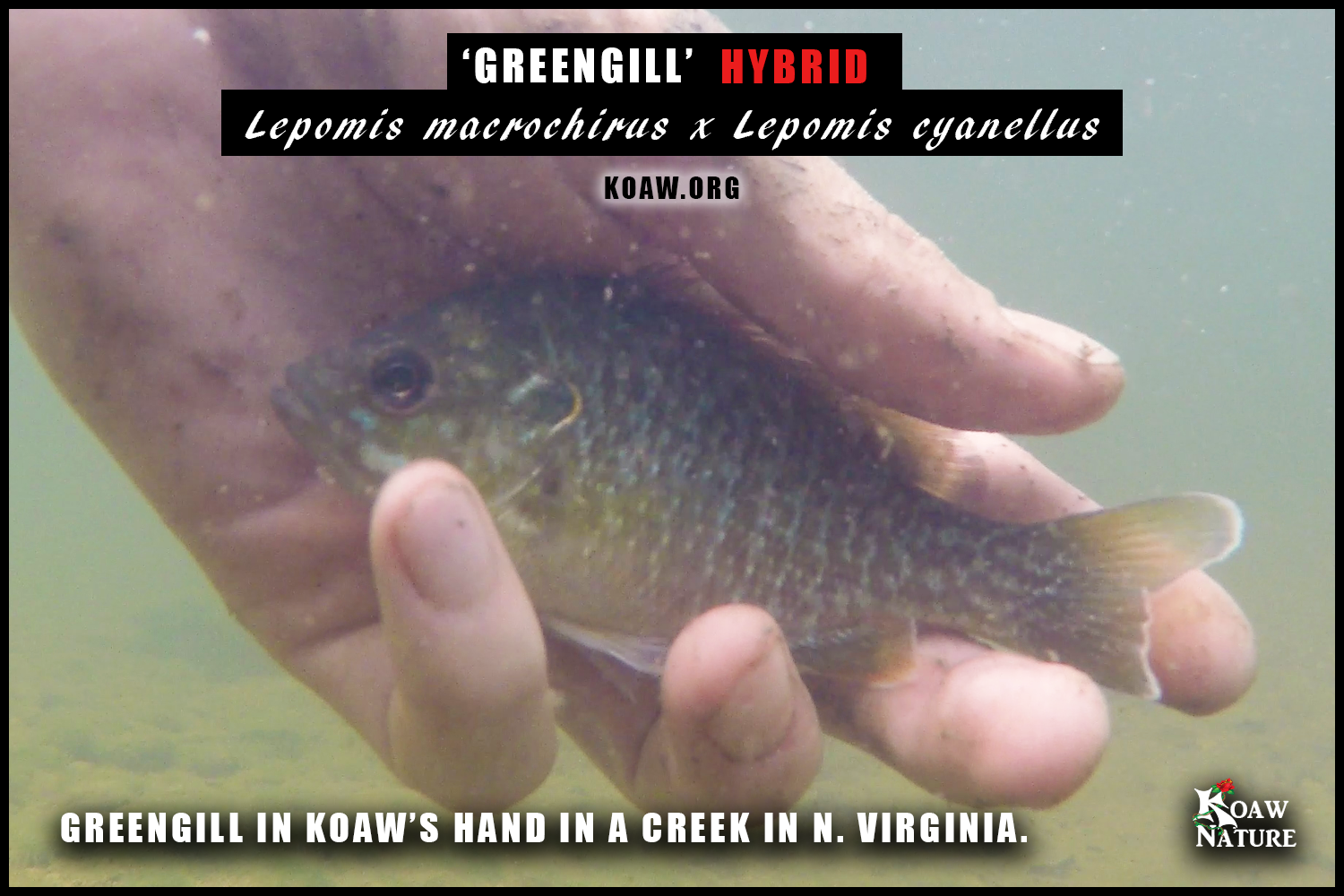By Koaw - November, 2020 (Updated - 2023)
This video summarizes the content on this page if you’d rather watch than read. Cheers!
GENERAL: Greengill is the common name given to the crossing of a bluegill (Lepomis macrochirus) and a green sunfish (Lepomis cyanellus), usually referring to (L. m. macrochirus x L. cyanellus). Over 140 years ago, Jordan and Nelson (1877) proposed the scientific name Lepiopomus ischyrus to greengill specimens in the National Museum that had been misidentified as longear sunfish (Lepomis megalotis, formally Pomotis aquilensis), as these scientists considered, like other ichthyologists before them, that greengill specimens were a distinct species and not the product of a hybridization event. [1] [2]
Click the graphic to enlarge.
In the late 1920’s and into the 1930’s, Hubbs & Hubbs (1931) would show that natural intraspecific hybridizations within the genus Lepomis were quite possible as various species of isolated pairs were allowed to spawn in tanks and produce survivable offspring, including the crossing of green sunfish and bluegill. [3] At the time, these crossings were considered to be intergeneric, or between genera, as the bluegill, green sunfish, longear sunfish, and pumpkinseed were all systematically placed, or suggested to be placed, in different genera, Helioperca, Apomotis, Xenotis, and Eupomotis, respectively.
In the aforementioned study, as well as in subsequent studies, it was demonstrated that these intraspecific crosses between green sunfish and bluegill usually produce intermediate characteristics, or characteristics that seem like a fairly even mix of genetic contribution from each parent species. [4] [5] [6] However it’s important to note that these characteristics, though described as intermediate, are not typically an exact split of the parental phenotypes and some characteristics will not be intermediate at all. [7] E.g. – The greengill’s opaque white margins on the median fins and pelvic fins are usually not present on the bluegill and at times even more pronounced on the greengill than on the green sunfish.
Natural hybridization between lepomids is still an uncommon occurrence, even if the genus shows greater tendency to hybridize and produce survivable offspring than most other groups of fishes. [5] Natural barriers exist that restrict hybridization events in lepomids, both psychologically and physically: Nesting site preferences, complex courtship displays that involve bodily gyrations and audible calls of grunts and pops, and lessened gamete compatibility are examples of barriers. [8] [9] Not to mention that lepomid sperm only survives for about 1 minute after dispersal, limiting the potentiality of cross-fertilization between nests. [4] Certain circumstances must exist for hybridizations to occur in the wild such as in closed systems where one parent species is significantly outnumbered by the other, limiting the availability of mates for the lesser abundant parent species. It is also possible that limited nesting grounds causes for extreme competition between males; a more aggressive species may limit the amount of males able to build suitable nests of the more passive species thus increasing the odds of females from the passive species spawning with the aggressive males.
Although Hubbs and Hubbs originally suggested that F1 hybrids, or first generation hybrids, of lepomids were sterile, or unable to produce viable offspring, Childers would later show that F2 populations were quite possible as well as backcrosses that involved the spawning of a hybrid into a pure parent species. [4] These F2 generations and backcrosses are likely extremely rare to occur in the wild for various reasons, one of which being that most hybrids have reduced gonads and male sperm is less abundant and irregularly formed. [5]
As far as identification goes, an F1 greengill is one of the less complicated types of hybrids to identify merely because this cross is fairly well-studied. The greengill is also one of the most prevalent hybrid types, both in the wild and within aquaculture. Many observation photos exist for examination, mostly from fishers across the United States.
Though let me reiterate advice from my ‘Introduction to Hybrids’ page: It’s often impractical to make a confident identification on a hybrid species without fully knowing the parent species involved and/or doing a DNA analysis. Hybrids may display very peculiar features especially when characteristics are far from intermediate between the parent species. Identification may be more complex if one or both of the parent species has introgressed DNA with other subspecies, other hybrids or even other species.
Fisheries Biologist Bob Jacobs describes hybridizations between lepomids with this analogy: “When they hybridize, their DNA gets shuffled like two dissimilar decks of cards.”
Before you attempt to identify a greengill, you should have at least a good understanding of how to identify a bluegill (L. macrochirus) and a green sunfish (L. cyanellus), and ideally, all the species within Lepomis. Although I will provide some photographs of specimens for reference, it is rather difficult to produce a ‘type specimen’ and ‘type features’ for any hybrid, as the variance is much greater than within any pure species.
BODY: The body shape is usually a good clue that a specimen may be a hybrid. Most hybrids often have irregularly shaped bodies. [10] Bluegill tend to have a deeper body, or a body that is more roundly, while green sunfish have a more elongate body, or more football-like. The greengill usually expresses an intermediate form. The lateral line usually remains complete on the greengill, similar to both parent species. (You’ll notice in the adjacent graphic of the specimen provided by Bob Jacobs that sometimes a greengill will maintain a very deep body rather than an intermediate, more elongated body.)
Greengill may have 10-11 (9) dorsal spines, 10 dorsal rays (11), 3 anal spines, 9-10 anal rays, and 13-14 pectoral rays. [11]
COLORATION:
WHITE/CREAM EDGES ON MEDIAN FINS & PELVIC FINS: This is perhaps the first best clue to examine on this hybrid type. The green sunfish usually has white edging on the distal edging of the pelvic fins, anal fin, caudal fin and 2d dorsal fin whereas the bluegill does not. The greengill inherits this white edging along the median fins from the green sunfish parent. The greengill’s pelvic fins often have an opaque whiteness covering most of the membranes that includes some yellow and orange.
The graphic shows close-up shots of the second dorsal fin of two different specimens of greengill.
DARK 2D DORSAL BLOTCH: The dark black dorsal blotch on the 2d dorsal fin is present on both parent species and is typically present on the greengill to some degree. However I have captured a few specimens where this blotch was greatly reduced to the proximal end of the fin and/or hardly visible; this faded/absent dorsal blotch is also seen in type photos presented in a couple of published studies. [4] [12] (Both specimens in the supporting graphic are greengill; the one on the right has a very faded dorsal blotch.)
BRIGHT BLUE STREAKING ON THE SNOUT/CHEEK/OPERCULUM: This is a feature usually intermediate between the parent species. Green sunfish usually have thin, bright blueish green iridescent streaks that start under the eye and extend laterally across the cheek and onto the operculum. Bluegill lack these bright blue streaks on the head. The greengill, if expressing this streaking, shows thicker lines with much less density of the blue colorations as is seen on the green sunfish. (This feature is actually good for comparing against a green sunfish x pumpkinseed (L. cyanellus x L. gibbosus) hybrid; when the aforementioned hybrid is produced, the blue streaking usually remains more connected and vibrant as it is seen on both parent species.)
BLUE VENTRALLY ON THE JAW/CHIN/OPERCULUM – One of the bluegill’s defining characteristics is the light blue that begins posteriorly on the jaws, extending ventrolaterally along the chin, cheek and into the operculum. With the greengill, the light blue exists in a similar area but is often broken, forming irregular light blue shapes.
LATERAL PATTERN: The lateral pattern along the body on a greengill is quite variable but usually does not appear like either parent species. Mature green sunfish have iridescent blue spots forming horizontal rows that are overlaid on faded dark vertical bars. Bluegill have dark vertical barring that is more apparent on females and non-parental males with no blue spotting.
The greengill often has vertical barring made up of yellow/orange/gold spots on a light blue or white background.
SIZE: In aquaculture, greengill are desirable for their faster growth rate compared to both parent species. [13] Childers recorded a 6-year-old F1 hybrid greengill at 31.9 cm (12.2 in) total length and weighing 965 g (2.1 lb), of which, I believe was a part of his hybridization experiments and not a wild-type. [4] Within a 3-month survey period, I analyzed measurements and meristics on only 11 of my wild caught greengill specimens. The average total length was 13.0 cm (5.1 in) TL with the largest specimen measuring 16.2 cm (6.4 in).
You might have heard the term ‘hybrid vigor’ when other fishers are discussing large hybrid specimens. It’s important to understand that capturing a large specimen does not necessarily mean that specimen is expressing hybrid vigor. Hybrid vigor, also known as positive heterosis, describes one or more traits of a hybrid offspring that offer an advantageous function for either survivability or reproduction that goes beyond the expression of either parental species. So although hybrid vigor for one or more traits may explain why a specimen is very large, it can only be assumed until many other variables are taken into account.
Although hybrid vigor seems an acceptable description for greengill growth rate in aquaculture specimens, the topic is too little studied to know if this translates into wild hybrid specimens. One study demonstrated that even though greengill show intermediate morphology of mouth and jaw size from the parental types, the feeding performance was not intermediate, displaying a nonlinear relationship of feeding performance and morphology where hybrids showed worse feeding performance than expected compared to both parental types; [12] this demonstrates the opposite of hybrid vigor.
It’s commonly accepted that greengill are more aggressive to a fisher’s bait. This aggressive behavior to food sources may be a form of hybrid vigor if it indeed translates into achieving greater consumption success than either parent species.
OPERCULAR FLAP: The opercular flap of the greengill typically expresses some red along the posterior edge with a ventral white edging. This coloration exists with great variance on this hybrid type. The red color is often thin and not pronounced, sometimes only faintly present for a few millimeters along the edge. At times the red color edges the entirety of the flap. White edging may exist both ventrally and dorsally along the flap or not at all. The ear flap remains short, typically not longer than the length of the eye.
GILL RAKERS: The gill rakers remain long and thin, as is seen on both parent species, but more so resembling the longer rakers of a green sunfish. These are seen by lifting up the gill plate and examining the longest rakers possible on that 1st gill arch.
I made a video describing how to locate and find these rakers that is hosted on Koaw Nature’s Fishing Smarts YouTube channel.
MOUTH SIZE: I choose to describe the greengill mouth and jaw as fairly large to moderately-sized as the posterior edge of the maxillary usually will align underneath the pupil or at least close to the anterior edge of the pupil. At times the maxillary may only extend to the edge of the eye.
PECTORAL FIN: The pectoral fin often exhibits an intermediate size relative to the parent species’ pectoral fins. Often the pectoral fin will align somewhere underneath the eye if bent forward.
Remember that most bluegill have a long, pointed pectoral fin that typically bends past the eye if it were bent forward. The green sunfish has a very short, roundly pectoral fin that usually does not extend to the eye if bent forward.
Typically there will be 13-14 pectoral rays.[11]
HABITAT: Greengill are found where bluegill and green sunfish are coexisting. Both species are quite successful in a variety of habitats such as creeks, rivers, ponds, lakes and various other impoundments. Both parent species are often associated with vegetation and slower moving water.
CLICK TO ENLARGE - This distribution map is an illustrated approximation created by Koaw primarily pulling data and information from USGS-NAS, Research Grade observations from iNaturalist and Page & Burr’s Field Guide to Freshwater Fishes.
LOCATION: Naturally occurring greengill will be found where bluegill and green sunfish are coexisting. Both species are the most ubiquitous lepomids in North America and both have been introduced widely outside of their native ranges.
In order to show possible greengill ranges, I have overlaid the maps I created for both the bluegill and the green sunfish. [14-18] These maps include the native and introduced ranges for both species.
FISHING: Hook-and-line anglers find greengill enjoyable to catch. The greengill is often more aggressive to baits than other lepomids in the same water; this aggressiveness often gives fishers the impression that hybrids are more abundant than they actually are.
I had success catching greengill with a number of methods. A spider-mimic fly with a size 10 hook caught many specimens in creeks and small lakes. Cut worms on a size 6 mosquito hook captured specimens along the Potomac River. Jigs with soft plastics work great as well. Small crankbaits and spinnerbaits should work fine.
Besides being more aggressive to the bait than either parent species, it’s in my observations that greengill do not hide in cover like the green sunfish so often does. None of the greengill specimens I captured popped out of hiding places, at least none that I captured in clear visibility water.
REFERENCES:
D. S. Jordan, "Contributions to North American Ichthyology No. 2," Bulletin of the United States National Museum, vol. 10, 1877.
R. Fricke, W. N. Eschmeyer and J. Fong, "Species by Family/Subfamily in the Catalog of Fishes," 2020.
C. L. Hubbs and L. C. Hubbs, "Experimental Verification of Natural Hybridization Between Distinct Genera of Sunfishes," Papers of the Michigan Academy of Science, Arts and Letters, vol. 15, pp. 427-437, 1931.
W. F. Childlers, "Hybridization of Four Species of Sunfishes (Centrarchidae)," Bull. Ill. Nat. Hist. Surv., vol. 29, no. 3, 1967.
C. L. Hubbs, "Hybridization between Fish Species in Nature," Systematic Zoology, vol. 4, no. 1, pp. 1-20, 1955.
D. A. Etnier, "Reproductive Success of Natural Populations of Hybrid Sunfish in Three Minnesota Lakes," Transactions of the American Fisheries Society, vol. 97, no. 4, pp. 466-471, 2011.
N. A. Neff and G. R. Smith, "Multivariate Analysis of Hybrid Fishes," Systematic Zoology, vol. 28, no. 2, pp. 176-196, 1979.
J. W. Gerald, "Sound Production During Courtship in Six Species of Sunfish (Centrarchidae)," Evolution, vol. 25, no. 1, pp. 75-87, 1971.
M. R. Gross, "Sneakers, satellites, and parentals: polymorphic mating strategies in North American sunfishes.," Zeitschrift für Tierpsychologie, vol. 60, pp. 1-26, 1982.
R. P. Jacobs and E. B. O'Donnell, "Sunfishes and Freshwater Basses," in Freshwater Fishes of Connecticut, Hartford, Connecticut Dept. of Environmental Protection, 2009, pp. 164-180.
Koaw, "Meristics and Morphometrics of Lepomids," 2020. [Online]. Available: https://www.koaw.org/lepomid-data.
M. D. McGee, J. W. Reustle, C. E. Oufiero and P. C. Wainwright, "Intermediate Kinematics Produce Inferior Feeding Performance in a Classic Case of Natural Hybridization," The American Naturalist, vol. 186, no. 6, pp. 807-814, 2015.
C. D. Webster and H. J. Tidwell, "Centrarchids: Hybrid Bluegill (Lepomis cyanellus x Lepomis macrochirus)," in Nutrient Requirements and Feeding of Finfish for Aquaculture, CAB International, 2002, pp. 381-387.
iNaturalist, "Green Sunfish - Lepomis cyanellus," [Online]. Available: https://www.inaturalist.org/taxa/58636-Lepomis-cyanellus. [Accessed 2020].
USGS - NAS, "Lepomis cyanellus," [Online]. Available: https://nas.er.usgs.gov/queries/SpeciesAnimatedMap.aspx?SpeciesID=380. [Accessed 2020].
iNaturalist, "Lepomis macrochirus Bluegill," iNaturalist, 2020. [Online]. Available: https://www.inaturalist.org/taxa/49591-Lepomis-macrochirus. [Accessed August 2020].
USGS, "USGS-NAS Lepomis macrochirus," [Online]. Available: https://nas.er.usgs.gov/queries/FactSheet.aspx?SpeciesID=385. [Accessed 2020 August].
L. M. Page and B. M. Burr, Peterson Field Guide to Freshwater Fishes, Houghton Mifflin Harcourt Publishing Company, 2011.




